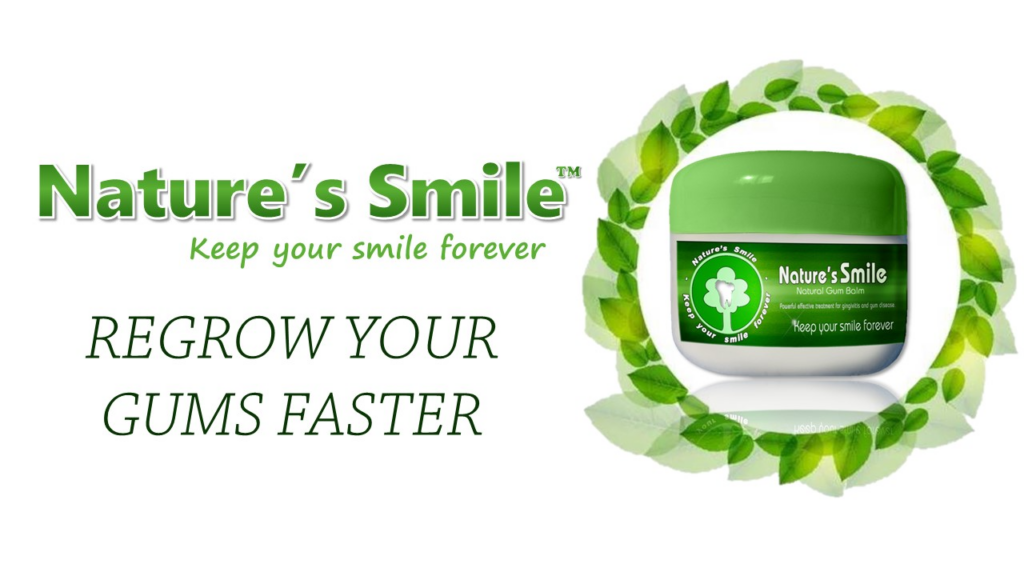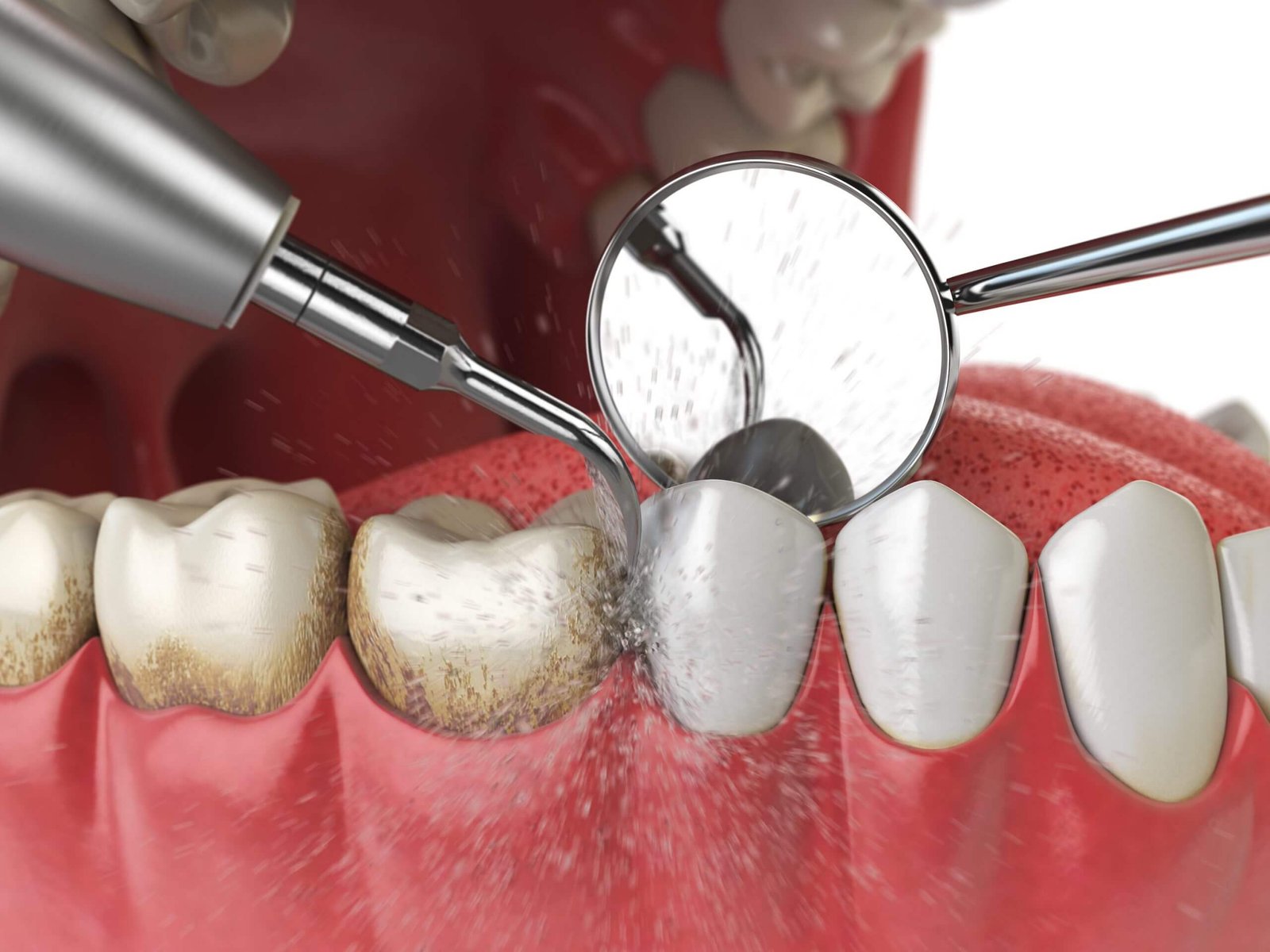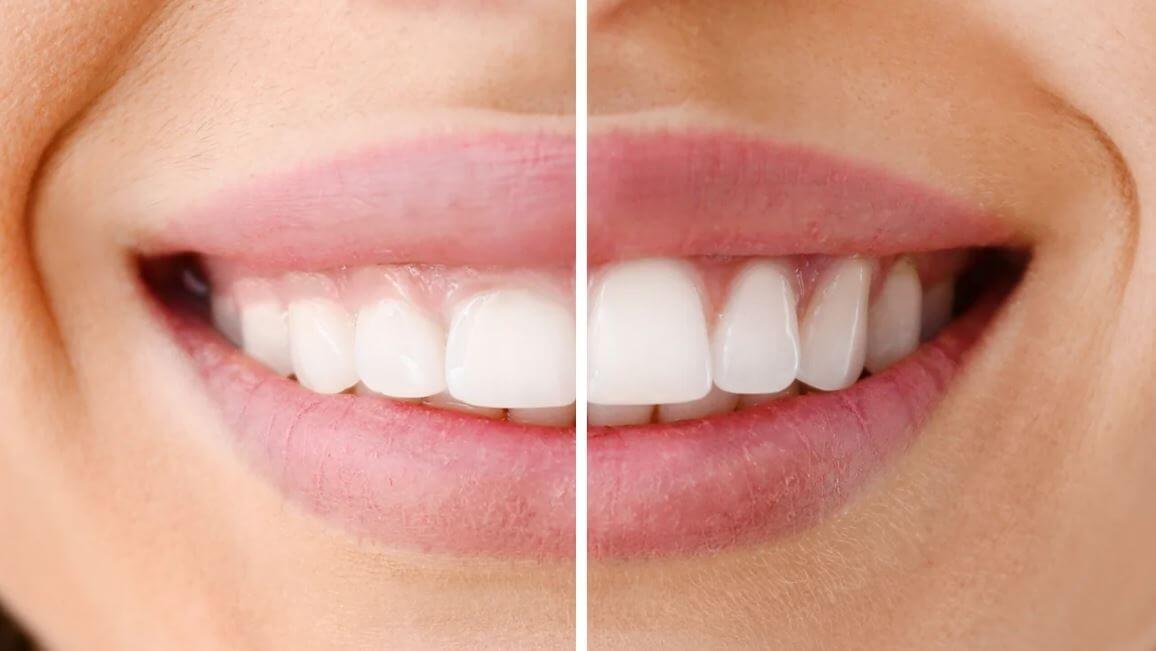Gum recession is a common dental problem that occurs when the gum tissue surrounding the teeth pulls back, exposing more of the tooth or its root. Gum recession can lead to sensitivity, tooth decay, and even tooth loss if left untreated. While non-surgical treatments for gum line such as scaling and root planing can help in mild cases, surgical treatments are often necessary for severe cases of gum recession.
In this article, we will explore the various surgical gum line treatments for restoring your gum. We will discuss soft tissue grafting, pinhole surgical technique, guided tissue regeneration, and combined treatments for optimal results.
By understanding these surgical options and their benefits, you can make an informed decision with your dentist on which treatment option is best suited for your specific case of gum recession. Additionally, we will discuss how to maintain healthy gums to prevent further gum recession from occurring in the future.
Understanding Gum Recession
Gum recession is a common dental condition that involves the gradual loss of gum tissue, often leading to exposed tooth roots and increased sensitivity.
This condition can occur due to a variety of reasons, including poor oral hygiene, aggressive brushing or flossing, genetic predisposition, orthodontic treatment, hormonal changes during pregnancy or menopause, and certain medical conditions such as diabetes and autoimmune disorders.
When the gums recede from the teeth, it creates pockets where bacteria can accumulate and cause further damage. One of the early warning signs of gum recession is tooth sensitivity to hot or cold temperatures.
As the gum line recedes, more of the tooth root becomes exposed to external stimuli that trigger nerve endings in the dentin layer. Other symptoms may include visible notches at the gum line (known as abfraction), longer-looking teeth than usual due to gum shrinkage, bleeding gums when brushing or flossing, and bad breath. If left untreated for long periods of time, severe cases of gum recession can lead to tooth loss.
In order to prevent further damage from occurring and restore your gum line’s health, it is important to address any underlying causes of gum recession as soon as possible. For instance, switching to a softer-bristled toothbrush and adopting gentler brushing techniques can help reduce mechanical trauma that exacerbates this condition.
Additionally, regular dental check-ups with a thorough cleaning and scaling procedure will remove tartar buildup around your teeth that harbor harmful bacteria which contribute towards gingivitis or periodontitis.
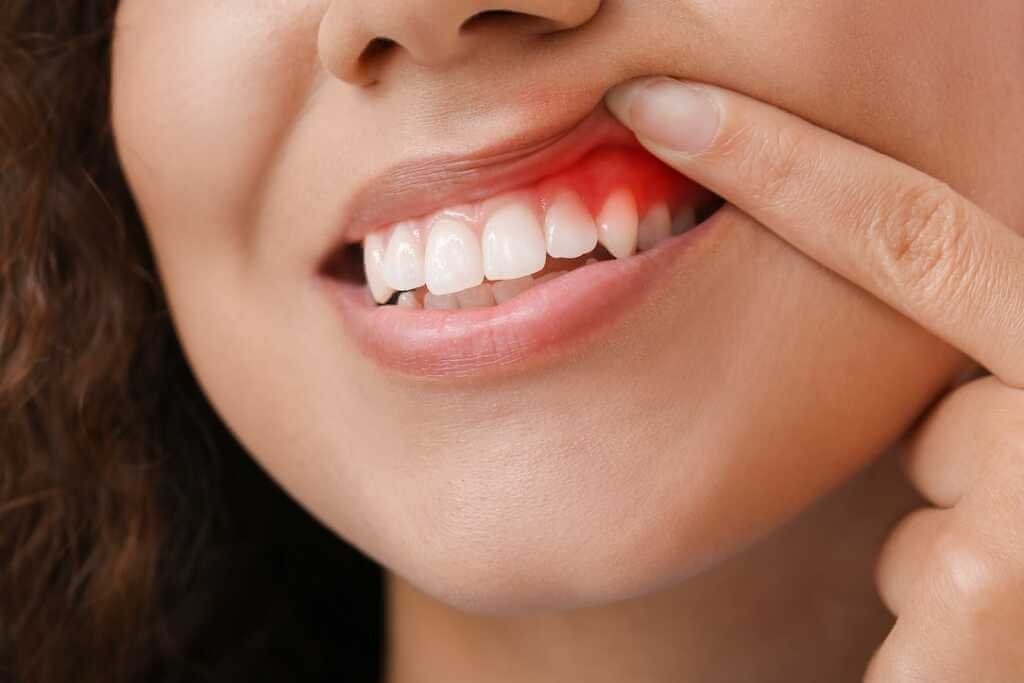
Non-Surgical Options for Treating Gum Recession
Non-invasive procedures can be utilized to address the issue of gum recession. These alternatives are often preferred by those who want to avoid invasive surgical treatments.
One option is scaling and root planing, which involves the cleaning of teeth below the gum line to remove plaque and tartar buildup that contributes to gum recession.
This procedure may help prevent further progression of gum disease and promote healthy tissue regeneration.
Another non-invasive alternative for treating gum recession is the use of natural remedies such as aloe vera, green tea, and coconut oil. Aloe vera has been shown to have anti-inflammatory properties that can reduce swelling in gums while green tea contains antioxidants that protect against oral bacteria.
Coconut oil pulling, or swishing coconut oil around in your mouth for several minutes before spitting it out, has also been found to help improve gum health by removing harmful bacteria.
While non-surgical options can be effective in addressing early stages of gum recession, they may not always be enough for more advanced cases. In these instances, surgical treatments for gum line may be necessary to restore the gum line.
These procedures may include soft tissue grafts or flap surgery where tissue from other parts of your mouth is grafted onto areas with receding gums or where existing tissue is repositioned over exposed roots respectively.
The Benefits of Surgical Treatments
Surgical interventions for gum recession have been found to offer significant benefits for patients with advanced cases of the condition, providing a viable option for improving oral health and preventing further damage.
One benefit of surgical treatments for gum line is that they can effectively restore the gum line to its natural position, reducing sensitivity and improving the appearance of teeth. Additionally, surgical treatments for gum line can also help prevent further bone loss by promoting tissue regeneration in areas where gums have receded.
One type of surgical treatment commonly used for gum recession is called pocket depth reduction surgery. This procedure involves folding back the affected gum tissue and removing bacteria from deep pockets that have formed around the teeth.
Once these pockets are cleaned out, the surgeon will then secure the gum tissue back in place over the tooth root using sutures. Another type of surgery used to treat gum recession is called regeneration surgery, which involves placing a regenerative material directly onto exposed tooth roots to encourage new bone and tissue growth.
While non-surgical options may be effective in treating mild cases of gum recession, surgical treatments for gum line offer long-term results and can prevent further damage caused by advanced stages of this condition. Furthermore, surgical treatments for gum line provide a more permanent solution compared to non-surgical methods which may require multiple visits or ongoing maintenance.
Soft Tissue Grafting
Soft tissue grafting is a technique commonly used to address advanced cases of gum recession that involves transplanting tissue from one area of the mouth to another. This procedure is typically performed under local anesthesia and can involve various types of grafts, such as connective tissue grafts, free gingival grafts, and pedicle grafts. The type of graft used will depend on the extent and location of the recession.
Donor tissue options for soft tissue grafting include autogenous (from the patient’s own body), allogeneic (from a donor), or xenogeneic (from an animal). Autogenous tissue is considered the gold standard because it has a lower risk of rejection and infection compared to other types. However, allogeneic and xenogeneic tissues can also be effective alternatives in certain situations.
Although soft tissue grafting is generally safe, there are potential risks and complications associated with this procedure. These may include bleeding, infection, pain, swelling, numbness or tingling in the affected area, scarring, and poor healing. Patients should discuss these risks with their dentist or periodontist before undergoing any surgical treatment for gum recession.
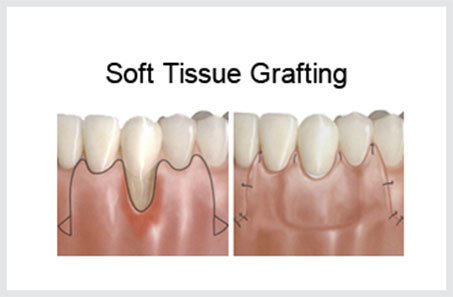
Pinhole Surgical Technique
The Pinhole Surgical Technique is a minimally invasive procedure that aims to correct gum recession. It involves making a small incision in the gums and then using specialized tools to loosen and reposition the tissue over the exposed tooth roots.
Recovery time for this technique is typically shorter than traditional gum grafting, with patients experiencing less pain and discomfort postoperatively. Additionally, advantages of this technique include no need for donor tissue and the ability to treat multiple teeth in one session with minimal discomfort.
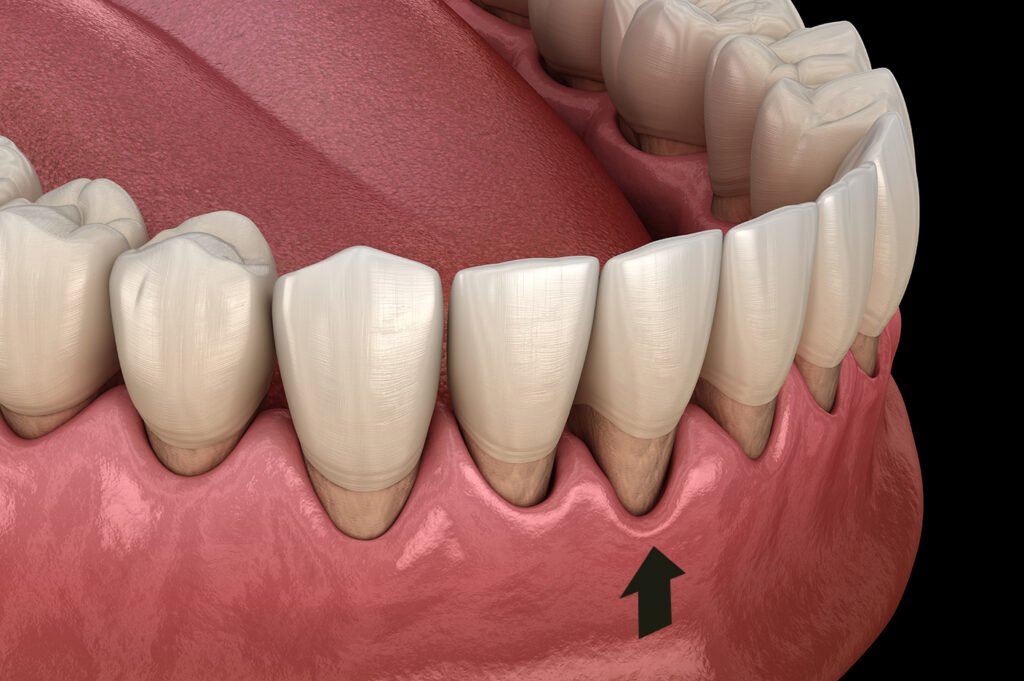
Procedure and Recovery
The procedure for restoring the gum line involves a comprehensive approach to address the underlying causes of gum recession and promote tissue regeneration, with an emphasis on proper post-operative care to facilitate a smooth recovery.
This surgical treatment typically begins with a thorough examination of the patient’s oral health history, followed by a personalized plan that takes into account their unique needs and any potential surgical risks.
During the surgery itself, the dentist will use specialized instruments to gently loosen and reposition the gum tissue, allowing it to cover more of the exposed tooth root. Once this is done, collagen strips or other materials may be used to help stabilize the gums in place as they heal.
To ensure long term outcomes after surgery, patients are advised to follow strict oral hygiene guidelines during their recovery period. This includes avoiding hard or crunchy foods that could damage the healing tissues, practicing gentle brushing techniques, and using special mouth rinses or gels as directed by their dentist. Patients will also need to attend regular follow-up appointments so that their progress can be monitored over time.
Four important factors that patients should consider before undergoing this type of surgery include:
- The overall health of their teeth and gums
- The extent of gum recession they are experiencing
- The skill level and experience of their chosen dental surgeon
- Their commitment to following post-operative care instructions
Advantages over traditional grafting procedures include faster healing times, less discomfort during recovery, and potentially better aesthetic results due to reduced scarring or swelling around treated areas.
Advantages over Traditional Grafting
This section highlights the advantages of using alternative techniques over traditional grafting procedures for addressing gum recession, including faster healing times, reduced discomfort during recovery, and potentially superior aesthetic outcomes.
One alternative technique is the use of acellular dermal matrix (ADM) grafts. Unlike traditional grafting procedures that require taking tissue from another part of the mouth or body, ADM grafts are made from donated human skin that has been processed to remove all cells, leaving only a collagen scaffold.
This eliminates the need for a second surgical site and reduces discomfort during recovery. Additionally, ADM grafts have been shown to promote faster healing times and potentially superior aesthetic outcomes compared to traditional grafting procedures.
Another alternative technique is the use of platelet-rich fibrin (PRF) therapy. PRF therapy involves drawing blood from the patient and processing it to concentrate platelets and growth factors before applying it directly to the affected area.
Benefits of this approach include reduced risk of infection since it uses the patient’s own blood products, quicker recovery times due to less invasive nature than traditional surgery, potential long-term stability in terms of soft-tissue coverage and cost-effectiveness as well as fewer visits required after initial treatment.
Cost considerations may also come into play when choosing between different treatment options for restoring your gum line; patients should be aware that while some alternatives may be more expensive up front than others such as traditional methods like connective tissue grafting (CTG), they could ultimately save money by requiring fewer follow-up visits or yielding better long-term results.
https://gumlinehealer.com/laser-therapy-for-healing-gums/
Guided Tissue Regeneration
Guided Tissue Regeneration is a surgical technique that involves the use of a barrier membrane to encourage the growth of new tissue and bone in areas where gum recession has occurred.
This procedure is an alternative to traditional gum grafting, which involves taking tissue from one area of the mouth and transplanting it into the affected area.
Guided Tissue Regeneration uses a small barrier membrane that is placed over the affected area to prevent unwanted tissue from growing while allowing new cells to regenerate.
The barrier membrane used in Guided Tissue Regeneration can be made from various materials such as collagen or synthetic polymers. Once placed over the affected area, it acts as a scaffold for new tissue growth, stimulating the body’s natural healing process. Additionally, this procedure can also involve bone grafting, which increases bone density and stability in areas where gum recession has led to bone loss.
Guided Tissue Regeneration offers several advantages over traditional gum grafting techniques. First, it requires less surgery since there is no need for harvesting donor tissue from another part of your mouth.
Second, it promotes faster healing due to its minimally invasive nature and ability to stimulate cell regeneration. Lastly, this procedure often leads to less postoperative pain and discomfort compared with traditional methods.
Combining Guided Tissue Regeneration with other dental treatments can lead to optimal results for patients with significant gum line recession issues. In particular, combining this technique with soft-tissue grafts or connective-tissue grafts can provide additional support for damaged gums while promoting further regeneration of both soft tissues and bones in those areas.
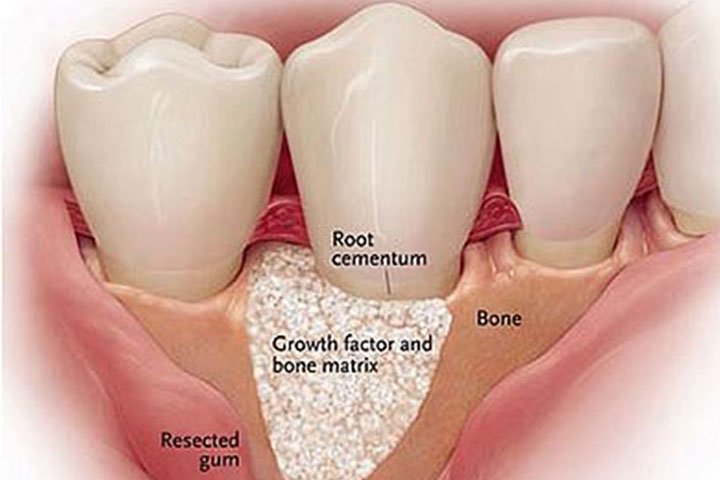
Combined Treatments for Optimal Results
Combined treatments for optimal results in gum line restoration involve the implementation of customized treatment plans and post-treatment care. Customized treatment plans are essential as they cater to the unique needs of each individual patient, ensuring that their specific condition is addressed effectively. Post-treatment care is equally important as it ensures that the healing process is smooth and uninterrupted, leading to successful outcomes in gum tissue regeneration.
Customized Treatment Plans
The implementation of individualized treatment plans plays a crucial role in achieving successful outcomes for patients seeking to address issues related to their gingival recessions. A personalized approach allows healthcare providers to tailor treatments based on the individual patient’s needs, lifestyle, and overall health status.
This customized approach can significantly improve treatment effectiveness by addressing the root cause of the problem and taking into account any unique factors that may impact the patient’s response to therapy.
To develop a customized treatment plan, healthcare providers may consider various factors such as the severity and location of the recession, patient age and medical history, as well as lifestyle habits like smoking or poor oral hygiene practices.
Additionally, they may incorporate specific therapies like tissue grafts or guided tissue regeneration procedures to promote optimal results. By taking this personalized approach, patients can receive care that is most suited to their specific needs while increasing their chances for successful gum line restoration.
Post-Treatment Care
Proper post-treatment care is essential in ensuring optimal recovery and long-term success of gingival recession treatment. Patients must follow their dentists’ instructions regarding aftercare to prevent complications such as infection, bleeding or swelling.
The first few days following surgery are crucial, and patients should avoid strenuous activities that may cause bleeding or discomfort. They should also avoid smoking, alcohol consumption, and spicy foods that can irritate the gums.
Patients should maintain good oral hygiene by brushing gently twice a day with a soft-bristled toothbrush and using an antimicrobial mouthwash. It is important to keep the surgical site clean and free of bacteria to prevent infection.
Patients should also attend all follow-up appointments with their dentist to monitor healing progress. Proper post-treatment care can help ensure successful recovery from gum line restoration surgery and promote long-term gum health.
In maintaining healthy gums, patients can continue practicing good oral hygiene habits like regular brushing and flossing to reduce the risk of future gum disease. Additionally, scheduling regular dental check-ups for professional cleaning can help maintain healthy gums. By taking preventative measures such as these, patients can maintain their beautiful new smile for years to come.
Maintaining Healthy Gums
Maintaining healthy gums is essential for preventing gum disease and other oral health issues. Daily oral hygiene practices such as brushing twice a day, flossing regularly, and using an antiseptic mouthwash can help keep your gums healthy. Additionally, regular dental check-ups with a professional can detect early signs of gum disease and provide necessary treatments to maintain optimal oral health.
Daily Oral Hygiene Practices
Adopting consistent and effective oral hygiene practices can contribute significantly to the overall health of your gums. One crucial aspect of maintaining healthy gums is flossing daily.
Flossing helps remove food particles and bacteria from areas where toothbrushes can’t reach, such as between teeth and under the gum line.
When choosing dental floss, it’s essential to opt for a type that suits your needs. For example, waxed floss slides more easily between teeth, while unwaxed floss provides a better grip on food particles.
Another critical factor in maintaining healthy gums is selecting the right toothbrush. A soft-bristled brush is gentle on the gums yet still effective at removing plaque from teeth surfaces.
Hard-bristled brushes can cause damage to both teeth and gums by wearing away enamel or causing bleeding. It’s also important to replace toothbrushes every three months or when bristles begin to fray since worn-out brushes are less effective at cleaning teeth and may harbor harmful bacteria.
To ensure optimal gum health, regular dental check-ups are necessary. These visits allow dentists to detect any signs of gum disease before it progresses into more severe stages that require invasive treatments such as surgery or periodontal therapy.
By adopting good oral hygiene practices and scheduling regular check-ups with your dentist, you can maintain optimal gum health for years to come.
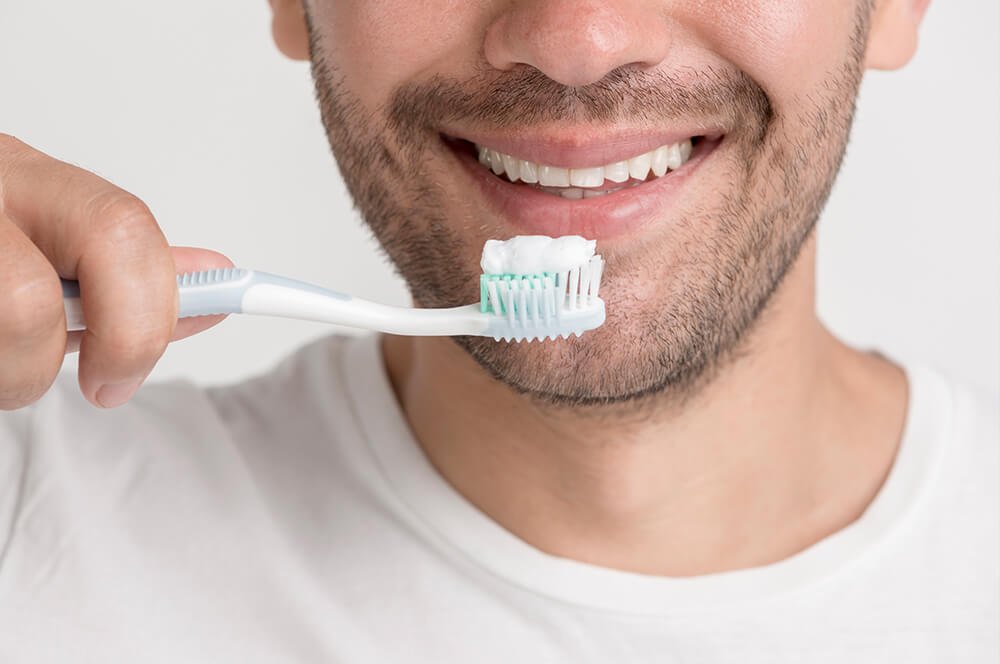
Regular Dental Check-Ups
Regular dental check-ups are crucial for detecting early signs of gum disease and preventing it from progressing to more severe stages. Preventive measures are always the best approach when it comes to oral health, and regular cleanings at the dentist’s office can help prevent gum disease from developing or worsening.
During a routine dental visit, your dentist or hygienist will examine your gums for redness, swelling, bleeding, and other signs of inflammation that could indicate gum disease.
In addition to examining your gums, your dentist will also perform a thorough cleaning of your teeth and gums during a routine visit. This cleaning helps remove plaque and tartar buildup that can contribute to the development of gum disease over time.
Regular dental check-ups not only help prevent gum disease but also enable early detection of any potential issues so that they can be treated before they become more serious problems. So, make sure you schedule regular appointments with your dentist or hygienist every six months for optimal oral health maintenance.
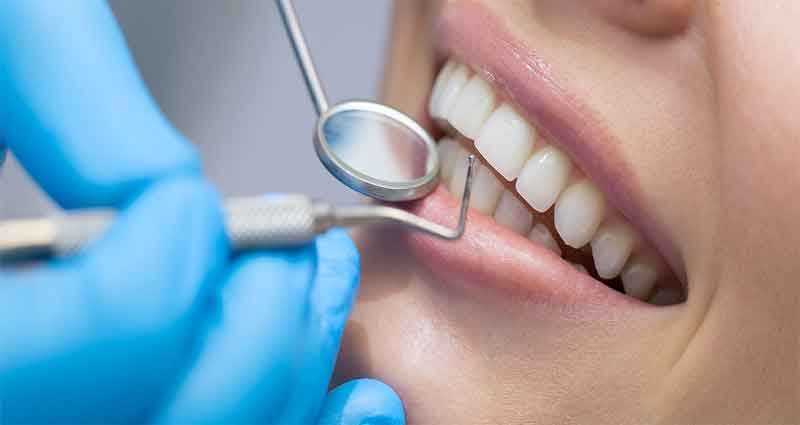
Further Entities
- https://en.wikipedia.org/wiki/Tooth_decay
- https://www.gov.uk/government/collections/oral-health
- https://content.ces.ncsu.edu/grafting-and-budding-nursery-crop-plants
Frequently Asked Questions
What are the risks and potential complications associated with surgical gum recession treatments?
Surgical treatments for gum recession have some potential risks and complications. One of the most common complications is infection, which can occur during or after surgery. Other possible complications include bleeding, swelling, pain, and sensitivity to hot or cold temperatures.
In rare cases, nerve damage may occur, leading to numbness or tingling in the affected area. It is important to note that these risks are relatively low and can be minimized by following proper post-operative care instructions given by your periodontist or dentist.
Overall, while surgical treatments for gum recession carry some potential risks and complications, they remain a safe and effective method for restoring your gum line and promoting healing.
Is there a specific age range or demographic that is more prone to gum recession?
Gum recession is a common dental problem that occurs when the gum tissue surrounding a tooth pulls back, exposing more of the tooth root. The causes of gum recession can be numerous and include periodontal disease, aggressive brushing, hormonal changes, tobacco use, teeth grinding, and poor oral hygiene.
Additionally, genetics may also play a role in gum recession susceptibility. Studies have shown that individuals with a family history of gum disease are more prone to developing this condition. Therefore, it is essential to maintain good oral hygiene practices and visit your dentist regularly to prevent gum recession from occurring or worsening.
How long does the recovery process typically take after a surgical gum recession treatment?
Recovery time after surgical gum recession treatment can vary depending on the individual and the extent of the procedure. Generally, patients can expect a recovery period of several weeks to a few months.
Post-operative care is crucial in ensuring proper healing and minimizing the risk of complications such as infection or bleeding. This may include following a specific diet, avoiding strenuous activities, taking prescribed medication, and maintaining good oral hygiene practices.
Close monitoring by a dental professional during this time is also important to ensure successful healing and prevent further damage to the gums. It is essential for patients to adhere to post-op care instructions provided by their dentist or periodontist for optimal results.
Are there any alternative or natural remedies for treating gum recession?
Natural remedies for treating gum recession have gained popularity in recent years. However, the effectiveness of these remedies remains largely unproven and is subject to debate. Some natural remedies that are commonly used include oil pulling, green tea, and aloe vera.
Oil pulling involves swishing oil (such as coconut or sesame) in the mouth for several minutes each day. Green tea contains antioxidants that may help reduce inflammation and promote healthy gums when consumed regularly.
Aloe vera is believed to have anti-inflammatory properties and can be applied topically to the gums. While these natural remedies may provide some benefits, they should not be relied upon as a substitute for professional dental care or proven treatments for gum recession. It is important to consult with a dentist before attempting any natural remedy to ensure it is safe and appropriate for individual needs.
Can gum recession be prevented altogether, or is it an inevitable part of aging?
Gum recession is a common dental problem that occurs due to various reasons, including aging factors and poor oral hygiene. While it may not be entirely preventable, there are certain natural remedies and lifestyle changes that can help slow down the process of gum recession.
Good oral hygiene practices, such as brushing twice a day and flossing regularly, can go a long way in preventing gum disease and subsequent recession. A diet rich in vitamins C and D, along with adequate hydration, can also support healthy gums.
Quitting smoking or using tobacco products is crucial since they have been linked to gum disease and recession. Ultimately, maintaining good overall health through regular exercise and stress reduction techniques will contribute to better oral health outcomes.
Conclusion
Gum recession is a common dental issue that can lead to several complications, including tooth sensitivity, decay, and even tooth loss. While non-surgical treatments like scaling and root planing or antibiotics may be effective in some cases, surgical treatments are often necessary for restoring the gum line effectively. Soft tissue grafting, pinhole surgical technique, and guided tissue regeneration are three surgical options that can help improve gum health and prevent further damage.
Soft tissue grafting involves taking a small amount of healthy tissue from one area of the mouth and attaching it to the affected area. Pinhole surgical technique uses a small incision to loosen the gum tissue and reposition it over the exposed root. Guided tissue regeneration involves placing a membrane between the gum tissue and bone to stimulate new growth. Combined treatments may also be recommended for optimal results.
Overall, seeking early surgical gum line treatments for gum recession is crucial in preventing further damage to your oral health. Maintaining good oral hygiene practices by brushing twice daily with fluoride toothpaste, flossing regularly, using an antiseptic mouthwash as directed by your dentist or periodontist can help prevent gum disease which leads to recession. Regular dental check-ups can also help catch issues before they become severe enough to require surgery. By working closely with your dental professional and following their recommendations for treatment, you can restore your gum line and maintain healthy gums long-term.


